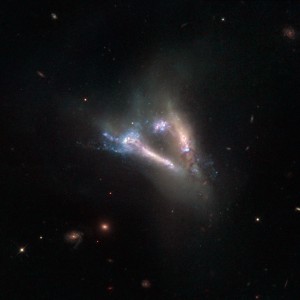
June 22, 2016, by Lindsay Brooke
The importance and consequences of colliding galaxies
Five hundred astronomers will gather in Nottingham at the end of June for the Royal Astronomical Society’s annual National Astronomy Meeting – #NAM2016. The UK’s biggest astronomy meeting takes place this year at The University of Nottingham’s Jubilee Campus for one week from the 27 June to the 1 July. In the run up to this prestigious event we are producing a series of blogs featuring some of the astronomy research being carried out at the University.
The School of Physics and Astronomy conducts world class research on the topic of galaxies and their evolution over time. Accompanying the academics and post-doctoral research associates are a contingent of PhD students pushing the boundaries of knowledge.
Carl Mundy is a final year PhD student in the School of Physics and Astronomy. He is investigating the merging histories of galaxies using observations of patches of sky which unveil galaxies that existed when the Universe was just 13% its current age. He is also chairing a session at #NAM2016 on the topic of galaxy mergers. Here’s his explanation of the work he’s doing and what ‘galaxy mergers’ are.

This large “flying V” is actually two distinct objects — a pair of interacting galaxies known as IC 2184. Both the galaxies are seen almost edge-on in the large, faint northern constellation of Camelopardalis (The Giraffe), and can be seen as bright streaks of light surrounded by the ghostly shapes of their tidal tails. These tidal tails are thin, elongated streams of gas, dust and stars that extend away from a galaxy into space. They occur when galaxies gravitationally interact with one another, and material is sheared from the outer edges of each body and flung out into space in opposite directions, forming two tails. They almost always appear curved, so when they are seen to be relatively straight, as in this image, it is clear that we are viewing the galaxies side-on. Also visible in this image are bursts of bright blue, pinpointing hot regions where the stars from both galaxies have begun to crash together during the merger. The image consists of visible and infrared observations from Hubble’s Wide Field and Planetary Camera 2. A version of this picture was entered into the Hubble’s Hidden Treasures image-processing competition by contestant Serge Meunier.
Galaxies are tightly bound collections of billions of stars and unthinkable amounts of dust that pepper the four dimensions of space and time. Our own galaxy, the Milky Way, is just one of the estimated one hundred billion galaxies that call the observable Universe home. In just under one hundred years astronomers have observed a veritable zoo of galaxies with all different shapes, sizes and colours stretching almost as far back as the birth of the Universe itself nearly 14 billion years ago. American astronomer Edwin Hubble, for whom the eponymous space telescope is named, was one of the first people to catalogue this staggering variety in 1926. Peering through the Hooker Telescope, the world’s largest in its time, Hubble observed red, elliptical galaxies as well as grand, gem-speckled blue spiral galaxies and all types in-between. This variety is still known today as the ‘Hubble Sequence’ of galaxies and is used by amateur and professional astronomers alike to define the shapes (morphologies) of galaxies.
One particular type of galaxy that Hubble, and countless others since, noticed were peculiar, irregularly-shaped galaxies. These rare objects do not fit into the tidy classifications (spiral, lenticular or elliptical) proposed by Hubble. One famous example of an irregular galaxy is NGC 520 — also known as Arp 157 — which, like the vast majority of irregular galaxies, is the violent result of a cosmic collision between two galaxies far back in time. Merging galaxies like this present often spectacular fodder for astronomers but are thankfully rare events. This rareity, however, has meant that astronomers have only just begun to unravel their role in the grander picture of galaxy evolution — i.e. how galaxies change through time. The importance and consequences of galaxy mergers is one of the most important questions in modern astronomy.
Through decades of observations and simulations astronomers have discovered surprising ways in which mergers impact galaxies. The most obvious impact is the increase in the (stellar) mass of a galaxy. When two galaxies collide the result is one galaxy with a mass equal to the sum of the two (or more) that forged it. Additionally, two colliding spiral galaxies can be transformed into a puffy and red elliptical galaxy given the right conditions and enough time. The act of merging is also found to destroy the resulting galaxy’s ability to birth new stars. On the other hand it has also been seen that the brief, flirtatious period before coallescence can spark a photogenic spell of star formation often accompanied by arcing tails of stars, gas and dust.
To make matters even more convoluted, very different fates await galaxies merging that possess very different masses. A situation in which one of the two galaxies is much less massive than the other means the smaller object is simply and quite unspectacularly absorbed into the larger one. These types of events are usually called minor mergers. The Milky Way is currently thought to have cannibalised small galaxies in this fashion in the past, and is expected to suffer a catastrophic major merger (where both galaxies are of similar masses/sizes) with its nearest neighbour — the Andromeda Galaxy — in a few billion years time. It is fair to say that galaxy mergers are a vibrant area of active study but are still poorly understood drivers of galaxy evolution. Understanding galaxy mergers and their impact on star formation and the shapes and sizes of galaxies drives many astronomers around the UK, and indeed the world. There will be several sessions at the National Astronomy Meeting (NAM) 2016 dedicated to the progress made in this exciting research area.
Suggested articles:
http://www.spacetelescope.org/images/potw1306a/
http://www.spacetelescope.org/images/heic1503a/
http://www.spacetelescope.org/images/potw1537a/
No comments yet, fill out a comment to be the first

Leave a Reply